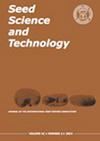Physiological and biochemical characteristics of cold stratification to overcome morphophysiological dormancy in Glehnia littoralis seed
IF 3
4区 农林科学
Q2 AGRONOMY
引用次数: 3
Abstract
Cold stratification is commonly used for breaking morphophysiological dormancy in Glehnia littoralis seeds. However, the physiological and biochemical characteristics of dormancy release are still unclear. For our study, dormant G. littoralis seeds were subjected to cold stratification (4°C). Physiological and biochemical characteristics, including germination percentage, the activities of antioxidant enzymes and α-amylase, and soluble sugar, soluble protein, H2O2, malondialdehyde (MDA) and coumarin were determined in imbibed seeds after different stratification periods (0, 30, 60, 90 or 120 days). The morphophysiological dormancy in G. littoralis seeds was completely released by cold stratification for 120 days. The activities of catalase (CAT) and content of hydrogen peroxide (H2O2) and total soluble sugars were significantly increased, while coumarins was significantly decreased during dormancy release. Dormancy release was significantly positively correlated with CAT activity (r = 0.903) and accumulation of H2O2 (r = 0.985) and total soluble sugars (r = 0.952), and significantly negatively correlated with coumarins (r = −0.919). Thus, the increase in H2O2, soluble sugars level and CAT activity and decrease in coumarins during cold stratification might contribute to promoting dormancy release in G. littoralis seeds.海苔种子冷分层克服形态生理休眠的生理生化特性
冷分层是一种打破沿海格列尼亚种子形态生理休眠的常用方法。然而,休眠释放的生理生化特征尚不清楚。在我们的研究中,对休眠的滨草种子进行冷分层(4°C)。在不同的分层时期(0、30、60、90、120 d),测定了种子的发芽率、抗氧化酶和α-淀粉酶活性、可溶性糖、可溶性蛋白、H2O2、丙二醛(MDA)和香豆素等生理生化特性。冷分层120 d后,海苔种子形态生理休眠完全解除。休眠释放过程中过氧化氢酶(CAT)活性、过氧化氢(H2O2)含量和总可溶性糖含量显著升高,香豆素含量显著降低。休眠释放与CAT活性(r = 0.903)、H2O2积累(r = 0.985)、总可溶性糖积累(r = 0.952)呈极显著正相关,与香豆素呈极显著负相关(r = - 0.919)。因此,冷分层过程中H2O2、可溶性糖水平和CAT活性的升高以及香豆素含量的降低可能促进了滨草种子的休眠释放。
本文章由计算机程序翻译,如有差异,请以英文原文为准。
求助全文
约1分钟内获得全文
求助全文
来源期刊

Seed Science and Technology
农林科学-农艺学
CiteScore
3.00
自引率
28.60%
发文量
36
审稿时长
>36 weeks
期刊介绍:
Seed Science and Technology (SST) is an international journal featuring original papers and articles on seed quality and physiology related to seed production, harvest, processing, sampling, storage, genetic conservation, habitat regeneration, distribution and testing. A journal that meets the needs of researchers, advisers and all those involved in the improvement and technical control of seed quality. Published every April, August and December.
 求助内容:
求助内容: 应助结果提醒方式:
应助结果提醒方式:


